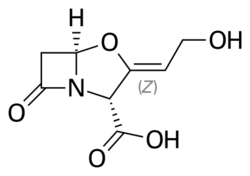Biology:Clavam
Clavams are a class of antibiotics. This antibiotic is derived from Streptomyces clavuligerus NRRL 3585.[1] Clavam is produced to form a new β-lactam antibiotic.[1] This class is divided into the clavulanic acid class and the 5S clavams class. Both groups are the outcomes of the fermentation process produced by Streptomyces spp.[2] Clavulanic acid is a broad-spectrum antibiotic and 5S clavams may have anti-fungal properties. They are similar to penams, but with an oxygen substituted for the sulfur.[3] Thus, they are also known as oxapenams.
An example is clavulanic acid,[4] from which this compound class receives its name.
Clavulanic acid, a type of Clavam, has antibiotic properties. It can be used as a medication to treat a variety of bacterial infections. CLAVAM tablets may be effective for short-term treatment of bronchitis, cystitis, sinusitis, otitis media, or skin infections.[5] Clavams are commonly used in conjunction with other antibiotics such as amoxicillin to produce a broader therapeutic effect. "One of the most valuable multipurpose and incredible trade of antibiotics is the beta-lactams group.[6]
Clavulanic acid strongly inhibits b-lactamase in bacteria, which is associated with its antibiotic properties. B - lactam antibiotics generally have a common feature which is the 3-carbon and 1-nitrogen ring (beta-lactam ring) that is highly reactive.[7] Different molecules of the Clavam class have been shown to inhibit the action of several fungal species. 5S Clavams do not have an inhibitory effect on b-lactamase, but are involved in methionine biosynthesis inhibition, making them bacteriostatic agents.[8] Additionally, 5S Clavams may have inhibitory effects on RNA synthesis, which is a common property of anti-fungal medications.[9] Clavams have wide-ranging bioactivity, and may have greater therapeutic use than current research indicates.[10] Because of their activity on b-lactamase, this class of antibiotics can evade antibiotic resistance in bacteria, which is a risk associated with other antibiotics such as penicillins.
Regulation of Clavam-biosynthesis in S. clavuligerus
In S Clavuligerus infection, a Streptomyces antibiotic regulatory protein known as CcaR (cephamycin and clavulanic acid regulator) are encoded into the Cephamycin gene cluster. This is essential for the cephamycin C and clavulanic acid but not the 5S claims. CcaR is important for the expression of polycistronic transcripts, which are early genes for clavulanic acid biosynthesis. This is also a key factor for activating its own transcription by binding to its own promoting region.[11]
References
- ↑ 1.0 1.1 Pruess, D. L.; Kellett, M. (1983). "Ro 22-5417, A NEW CLAVAM ANTIBIOTIC FROM STREPTOMYCES CLAVULIGERUS I. DISCOVERY AND BIOLOGICAL ACTIVITY" (in en). The Journal of Antibiotics 36 (3): 208–212. doi:10.7164/antibiotics.36.208. ISSN 0021-8820. PMID 6833140. https://www.jstage.jst.go.jp/article/antibiotics1968/36/3/36_3_208/_article/-char/ja/.
- ↑ Jensen, S. E. (22 August 2012). "Biosynthesis of cavan metabolites". https://watermark.silverchair.com/jimb1407.pdf?token=AQECAHi208BE49Ooan9kkhW_Ercy7Dm3ZL_9Cf3qfKAc485ysgAAA28wggNrBgkqhkiG9w0BBwagggNcMIIDWAIBADCCA1EGCSqGSIb3DQEHATAeBglghkgBZQMEAS4wEQQMakuIRI5fpvK7N6LzAgEQgIIDIj4e6-xSz88B9ORczIVhGiTQhsnLDB4Riyc7RguseeCSs_3Vb8Wc8rEiaMTCqH0D33AA2FSvqDygHaeDRSd8rXrmVdoDN4KMYMzT9oekY_tf25sGle5WYfUFX6D43e0S1Ug4obMJmShCxsOwZF7saGUUsZxBinuLr8voVAtQA3bjjhhMOfCxl0pA9t_anHrl86NDB8KjUVO-KrmoNF2BdIysFuuYKlBivjse7oWhp4LvZfkz0zfiXQGbScQaxY0g0UxjjduBG_GL8phZYlf1Qua7uxEoIr5KMvZvl01TjxcqzhuvTYQnW0gRdu1DjqjmIVN8Bh2EaWG6Yb_Vx4exTSEiuf5oXlqe1i0rrArn-qpeBSKASWaXH1iJe_AE_jgg7fFrln4-JbDiFFhiO3vNsdg_RuP4mKymKprN0u1Ztvg0uKCXmzL-kpDwBG9edack7Gr0Z0iM9hsrAGYm8LgskYiylYffDeouBoADxgCSYZbo-eTna2pyCS7aPRi2wCRAa-5RHC3VGUWsy-8iI1Fqm5IpFoVL6PnKarokNVhJYQapsn2xyWdmVL3Bu92K5CnLhCE2oUVRmtM2rzpsuNpoNZpmGOeNsnE3P50iLoxZRdnUYDqJIXlJLA_WRDbsfrk3pfgsM6Xg18ccKqe0W8yiND5VLUt-qLLGkUUoZGuNx3MK0N3wYMYJQ_41nfC_2FJas2fmljB4ryMAvA90SttLz3CFsihaiLkcLbDdWLxMUcRmI5iTpt3yuzasy8YMe32Ef8EKLRGEYNKDtCpAuUUcxHcQhhwQtjfMJxnXVXxD548hBNG2FsSnl54JTnfhVGXebzgmQrkNQ-mr_cIeIXUzVFcux-d6Ll23v26AJJWKrze9q6zuGJjvgcZP169cbbIhTwDuHNnKuKmUdA8yRzSvP-6ZD4CTslCyklN-jVnCYk9XElNLVKLwRwMCiEn2pDqoMsSukgdej4Da9GOVpEVu-StdW4ewlcIvoDlBkoyEs5FtNxuXg0-RgyhCFW8fWiMUFtWIQxxiO7gT7UOaW5CjS0Qoat6uZRKE5Hf5LWE5BVZiJdY.
- ↑ "Medscape.com". http://www.medscape.com/viewarticle/464632_2.
- ↑ Chemical Research Laboratory, Oxford University (The Schofield Group). "Antibiotic Biosynthesis, Clavulanic Acid Mode of Action and Biosynthesis". http://www.chem.ox.ac.uk/oc/cjschofield/biosynthesis.htm.
- ↑ "Clavam" (in en). 8 September 2020. https://www.nps.org.au/medicine-finder/clavam-tablets.
- ↑ Chmielewski, Marek; Cierpucha, Maciej; Kowalska, Patrycja; Kwit, Marcin; Frelek, Jadwiga (2008-05-15). "Structure–chiroptical properties relationship in clavams: An experimental and theoretical study" (in en). Chirality 20 (5): 621–627. doi:10.1002/chir.20484. ISSN 0899-0042. PMID 17924419. https://onlinelibrary.wiley.com/doi/10.1002/chir.20484.
- ↑ Pandey, Neelanjana; Cascella, Marco (2022), "Beta Lactam Antibiotics", StatPearls (Treasure Island (FL): StatPearls Publishing), PMID 31424895, http://www.ncbi.nlm.nih.gov/books/NBK545311/, retrieved 2022-04-04
- ↑ Jensen, Susan E (2012-10-01). "Biosynthesis of clavam metabolites". Journal of Industrial Microbiology and Biotechnology 39 (10): 1407–1419. doi:10.1007/s10295-012-1191-0. ISSN 1476-5535. PMID 22948564.
- ↑ Röhl, F.; Rabenhorst, J.; Zähner, H. (1987-05-01). "Biological properties and mode of action of clavams" (in en). Archives of Microbiology 147 (4): 315–320. doi:10.1007/BF00406126. ISSN 1432-072X. PMID 3304182. Bibcode: 1987ArMic.147..315R. https://doi.org/10.1007/BF00406126.
- ↑ Cierpucha, Maciej; Panfil, Irma; Danh, Tong Thanh; Chmielewski, Marek; Kurzatkowski, Wieslaw; Rajnisz, Aleksandra; Solecka, Jolanta (October 2007). "Synthesis of 3-Substituted-clavams: Antifungal Properties, DD -Peptidase and β-Lactamase Inhibition" (in en). The Journal of Antibiotics 60 (10): 622–632. doi:10.1038/ja.2007.80. ISSN 1881-1469. PMID 17965478.
- ↑ E Jensen, Susan (2012). "Biosynthesis of clavam metabolites". Journal of Industrial Microbiology & Biotechnology 39 (10): 1407–1419. doi:10.1007/s10295-012-1191-0. PMID 22948564.
 |


